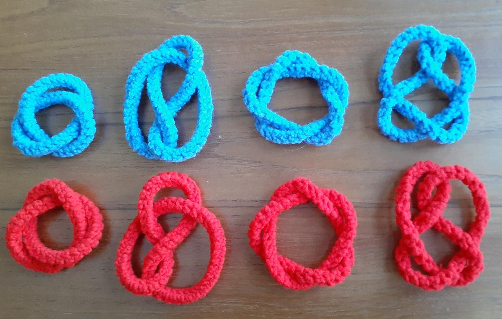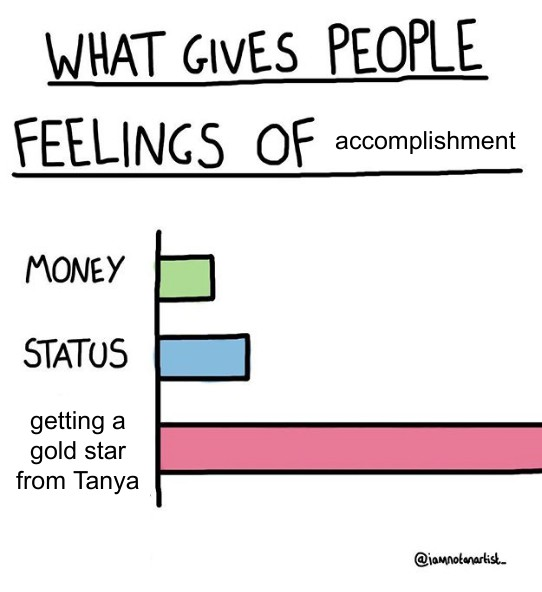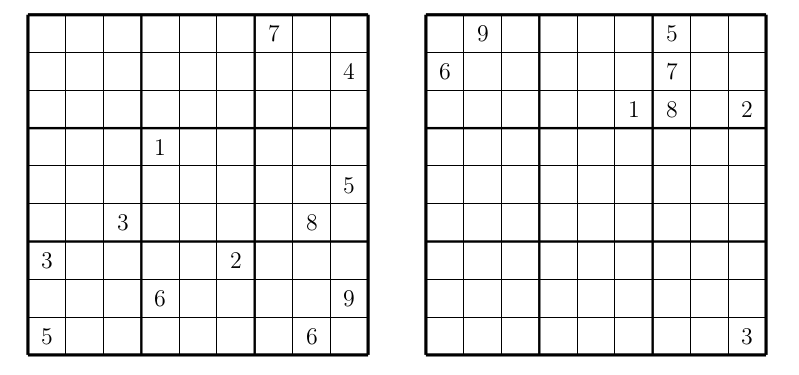Archive for the ‘Math Education’ Category.
28th January 2022, 11:20 am
Here is a classical puzzle I often give to my students.
Puzzle. The sultan has three red hats and two blue ones. He wants to test his three wizards, who know his hat collection. He asks them to close their eyes and puts a hat on each of their heads. After the wizards open their eyes, they see each other’s hats, but not their own. The sultan asks each of them to guess the color of their own hat, without communicating with each other. In this particular test, the sultan only puts red hats on the wizards’ heads. Sometime after the wizards open their eyes, one of them guesses his hat’s color. How did he guess?
Here is how my students explain the solution. If a wizard sees two blue hats, he immediately knows that his hat must be red. That means, if no one immediately announces their hat’s color, at least two of them are wearing red hats. In this case, if a wizard sees one red hat, he knows that his hat must also be red. So such a wizard can guess the color of his hat. If after some more time, no one announces their hat color, all the hats worn must be red.
After the students solve the problem, I run an evil experiment on them. I show the students my two blue and three red hats and ask three volunteers to close their eyes. Then, I put two red hats and one blue hat on their heads, and the blue hat goes on the fastest thinker in the group. I did this experiment many times. Half the time, the fastest thinker overestimates how fast the other students think and guesses, mistakenly, that s/he is wearing the red hat. Gotcha!
After the experiment, we discuss what is really going on in this puzzle. This is how I start my class on common knowledge.
Share:





19th January 2022, 11:38 am
I plan to teach knot theory to my students. So, I made four blue knots which are actually the four simplest non-trivial knots. Then I made the red ones which are mirror images of the blue ones.
Then I fiddled with the figure-eight knots, which are the second ones from the left. Out of all these four types of knots, the figure-eight knot is the only one that is amphichiral: its mirror image is equivalent to itself. It was fun to physically transform the red one to look identical to the blue one. So, I decided to crochet another pair of figure-eight knots for my students to fiddle with.
Did I mention that I hate crocheting?
Share:





25th December 2021, 12:33 pm
14th December 2021, 06:29 pm
Here is a cute old problem that Facebook recently reminded me of.
Puzzle. By mistake, a clock-maker made the hour hand and the minute hand on a clock exactly the same. How many times a day, you can’t tell the current time by looking at the clock? (It is implied that the hands move continuously, and you can pinpoint their exact location. Also, you are not allowed to watch how the hands move.)
Here is the solution by my son who was working on it together with my grandson.
The right way to think about it is to imagine a “shadow minute hand”, like this: Start at noon. As the true hour hand advances, the minute hand advances 12 times faster. If the true minute hand were the hour hand, there would have to be a minute hand somewhere; call that position the shadow minute hand. The shadow minute hand advances 12 times faster than the true minute hand. The situations that are potentially ambiguous are the ones where the shadow minute hand coincides with the hour hand. Since the former makes 144 circuits while the latter makes 1, they coincide 143 times. However, of those, 11 are positions where the true minute hand is also in the same place, so you can still tell the time after all. So there are 132 times where the time is ambiguous during the 12-hour period, which leads to the answer: 268.
I love the problem and gave it to my students; but, accidentally, I used CAN instead of CAN’T:
Puzzle. By mistake, a clock-maker made the hour hand and the minute hand on a clock exactly the same. How many times a day can you tell the current time by looking at the clock?
Obviously, the answer is infinitely many times. However, almost all of the students submitted the same wrong finite answer. Can you guess what it was? And can you explain to me why?
Share:





15th October 2021, 03:24 pm
I like rewarding my students. Before covid, I used to give them star stickers for good ideas. When I started to teach remotely, I wondered what I should do instead. I could tell them that they had won a star, but it felt too weak. The next idea was to show them a star and tell them that it belonged to them. But that still felt insufficient. Then I had an epiphany. I would say to them they earned a star, show it to them, and stick it to my face. So they, and all the other students, would see it for the rest of the class. The photo shows how I looked at the end of a successful lesson.
Another picture shows what my MathRoots students posted on our Discord channel.
Now that I am back teaching in person, my students asked me to continue sticking their stars to my face. Sometimes I forget about the stars and, after my class, wander around MIT star-covered.
Share:





19th September 2021, 05:30 pm
My students (Matvey Borodin, Eric Chen, Aidan Duncan, Boyan Litchev, Jiahe Liu, Veronika Moroz, Matthew Qian, Rohith Raghavan, Garima Rastogi, Michael Voigt) and I recently wrote a paper connecting the stable marriage problem and Sudoku. I just blogged about it. By the way, my students are in grades 7-9.
On the way, we invented a new type of Sudoku, which we call joint-groups Sudoku. This type is in contrast to a famous type of Sudoku, called disjoint-groups Sudoku. In a disjoint-groups Sudoku, in a particular place in a 3 by 3 box, all the digits are distinct across all the boxes. For example, the top-left corners of nine boxes have all the digits 1 thought 9. This creates nine additional disconnected regions (depending on the placements inside a 3 by 3 box) to add to columns, rows, and boxes that have to contain distinct digits.
For our new type, we wanted the digits in a particular place in each box, instead of being different, to be the same as much as possible. How much of sameness is possible? The first row contains three top-left corners. Thus, by Sudoku rules, these top-left corners have to be distinct. Thus, the top-left corners in all nine boxes have to contain at least three distinct digits. So here is the rule for the joint-groups Sudoku: the nine digits in a particular place in a 3 by 3 box contain not more than three distinct digits. It is easy to see that it means they contain exactly 3 distinct digits, each of them three times.
Here are two Sudoku puzzles from our paper. Each puzzle, when completed, forms a joint-groups Sudoku.
Share:





3rd September 2021, 05:53 pm
As you may know, I run PRIMES STEP, a local program where we do mathematical research with students in grades 6-9. Last academic year, we looked at the stable marriage problem and discovered its connection to Sudoku. Our paper The Stable Matching Problem and Sudoku (written jointly with Matvey Borodin, Eric Chen, Aidan Duncan, Boyan Litchev, Jiahe Liu, Veronika Moroz, Matthew Qian, Rohith Raghavan, Garima Rastogi, Michael Voigt) is now available at the arxiv.
Consider 3 men and 3 women who want to be married to each other in heterosexual couples. They rank each other without ties. The resulting 6 permutations of numbers 1, 2, and 3 that describe the six rankings are called the preference profile of this group of people. A matching is unstable if two people would be happier to run away together than to marry into the assigned couples. The two potential runaways are called a rogue couple. A matching is called stable if no rogue couple exists. The Gale-Shapley algorithm, invented by Gale and Shapley, finds a stable matching for any preference profile, implying that stable matching is always possible.
We discovered that preference profiles form a natural bijection with ways to place one digit into a Sudoku grid. So we wrote a paper describing the stable marriage, rogue couples, the Gale-Shapley algorithm, soulmates, and such in terms of Sudoku.
Oops, I forgot to explain who the soulmates are. We invented this term to describe two people who rank each other first. Though it is possible to have several stable matchings for the same preference profile if the soulmates exist, they must always be matched together.
We also invented a new Sudoku type, which I will explain next time.
Share:





21st September 2020, 03:09 pm
For the last year, I’ve been obsessed with Penney’s game. In this game, Alice picks a string of coin tosses, say HHH for three heads. After that, Bob picks his string of tosses of the same lengths, say HTH. Then they toss a fair coin. The person whose string shows up first wins. For example, if the tosses are THTTHHH, then Alice wins after the seventh toss. For these particular choices, Bob wins with probability 3/5.
With my PRIMES student, Sean Li, we looked at this game and asked a different question. Suppose Alice picks a pattern of three tosses in a row that are the same. Suppose after that, Bob chooses a pattern of three alternating tosses. Then they toss a fair coin. Alice is hoping for HHH or TTT, while Bob is hoping for HTH or THT. The person whose pattern shows up first wins. For example, if the tosses are THTTHHH, then Bob wins after the third toss. For these particular choices, Bob wins with probability 1/2.
In this example, what actually happens. We assume that the group of two elements acts on the alphabet of two letters. The group’s non-identity element swaps letters H and T. We assume that two strings are equivalent if they belong to the same equivalency class under the group action. We call such an equivalency class a pattern.
In the new game we invented, we have an alphabet of any size and any group acting on the alphabet. Then Alice and Bob pick their patterns. After that, they play the Penney’s game on these patterns. The answers to all the relevant questions are in our paper, The Penney’s Game with Group Action, posted at the math.CO arxiv 2009.06080.
Share:





5th August 2020, 04:51 pm
I wrote a paper Confirming the Labels of Coins in One Weighing together with my PRIMES STEP students Isha Agarwal, Paul Braverman, Patrick Chen, William Du, Kaylee Ji, Akhil Kammila, Shane Lee, Alicia Li, Anish Mudide, Jeffrey Shi, Maya Smith, and Isabel Tu. The paper is available at math.HO arxiv:2006.16797. Below my students describe what happens in the paper in their own words.
Tragedy has struck in an iCOINic land known as COINnecticut. One day, while everyone was minding their own business, the vault door of the bank was found to have been forcefully opened. COINcerns spread amongst the COINmoners that someone had tampered with their n sacred COINtainers of coins! The COINtainers are labeled with the integers 1 through n, which usually describe the weight of each of the countless coins inside that corresponding COINtainer. For example, the COINtainer labeled 1 should only COINtain coins that weigh 1 gram, the COINtainer labeled 2 should only COINtain coins that weigh 2 gram, and so on, you get the COINcept.
The acCOINtants COINclude that someone may have switched around the labels on the COINtainers. To resolve this COINplication, aka to check if the labels have been tampered with, they bought a balance scale for a microsCOINpic amount of money. However, they can only use the scale to COINduct one weighing as the angry COINmoners are impatient and wish to withdraw their money ASAP.
The COINfused acCOINtants COINvinced 11 COINspicuous students from Boston’s COINmunity to help them. With their COINbined efforts, they COINcluded that indeed, no matter how many COINtainers there are, their labels can be COINfirmed as correct or incorrect with just one weighing! Unfortunately, sometimes, such a weighing requires the use of many coins or coins with a large COINbined weight, which could potentially break the scale. Seeing this COINundrum, the students wished to be eCOINomical and find the least amount of coins or weight they need to place on the scale.
The acCOINtants and the 11 students COINtinued examining the nature of these weighings and discovered patterns that occur within them. They COINfined their research to special weighings they called downhill. They COINfirmed the effectiveness of such weighings to solve the problem at hand. The students estimated the weight and the number of coins, thus COINpleting their task.
Share:





26th June 2020, 04:01 pm
My STEP students invented a coin-flipping game that doesn’t require a coin. It is called The No-Flippancy Game.
Alice and Bob choose distinct strings of length n consisting of the letters H (for heads) and T (for tails). The two players alternate selecting the outcome of the next “flip” to add to the sequence by the rule below.
The “flip” rule: Let i < n be the maximal length of a suffix of the sequence of chosen outcomes that coincides with a prefix of the current player’s string. The player then selects the element of their string with index i + 1 as the next term in the sequence.
Alice goes first, and whoever’s string appears first in the sequence of choices wins. In layman terms, the game rules mean that the players are not strategizing, but rather greedily finishing their strings.
Suppose n = 2 and Alice chose HH. If Bob chooses HT, then Bob wins. Alice has to choose H for the first flip. Then Bob chooses T and wins. On the other hand, if Bob chooses TT for his string, the game becomes infinite. On her turn, Alice always chooses H, while on his turn Bob always chooses T. The game outcome is an alternating string HTHTHT… and no one wins.
Suppose n = 4, Alice chooses HHTT, and Bob chooses THHH. The game proceeds as HTHHTHHH, at which point Bob wins.
This game is very interesting. The outcome depends on how Alice’s and Bob’s chosen strings overlap with each other. We wrote a paper about this game, which is available at math.CO arXiv:2006.09588.
Share:








